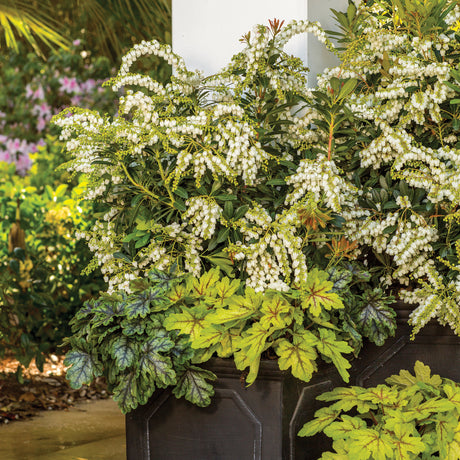FiltersFilter & Sort
Southern Living Plant Collection
From $19.98Unit price /UnavailableIn stock (432)
Pieris, also known as Lily of the Valley shrub or Andromeda, is an evergreen shrub that is popular for its stunning foliage and delicate flowers. Here are some reasons why you should consider adding Pieris to your garden and how to care for them.
- Beautiful Foliage: Pieris has glossy, dark green leaves that are lance-shaped and can be up to 6 inches long. Some cultivars have leaves that are tinged with red or bronze, and some have variegated foliage. The foliage is a beautiful addition to any garden and provides year-round interest.
- Attractive Flowers: Pieris produces small, bell-shaped flowers that are usually white or pink. The flowers hang in clusters and can cover the entire plant, creating a stunning display. The flowers bloom in early spring, providing a much-needed burst of color after a long winter.
- Low Maintenance: Pieris is a relatively low-maintenance shrub. It does well in partial shade and prefers well-drained, acidic soil. Once established, it is drought-tolerant and doesn't require much watering. Pieris is also resistant to most pests and diseases.
- Versatility: Pieris can be grown as a specimen plant, a foundation planting, or as part of a mixed border. It can also be grown in containers, making it a great choice for small gardens or balconies.
- Planting: Pieris prefers well-drained, acidic soil. If your soil is alkaline, you can amend it with peat moss or compost. Plant Pieris in a location that receives partial shade or filtered sunlight. Full sun can scorch the leaves, while too much shade can reduce flower production.
- Watering: Water Pieris regularly during its first year of growth to help it establish a strong root system. After that, it is drought-tolerant and doesn't require much watering. However, if your area experiences a long dry spell, it's a good idea to water your Pieris to keep it healthy.
- Fertilizing: Pieris benefits from an application of a slow-release fertilizer in early spring before new growth appears. Use a fertilizer formulated for acid-loving plants, such as azaleas or rhododendrons.
- Pruning: Prune your Pieris after flowering to shape it and remove any dead or damaged branches. Avoid pruning in late summer or fall, as this can remove the buds for next year's flowers.







